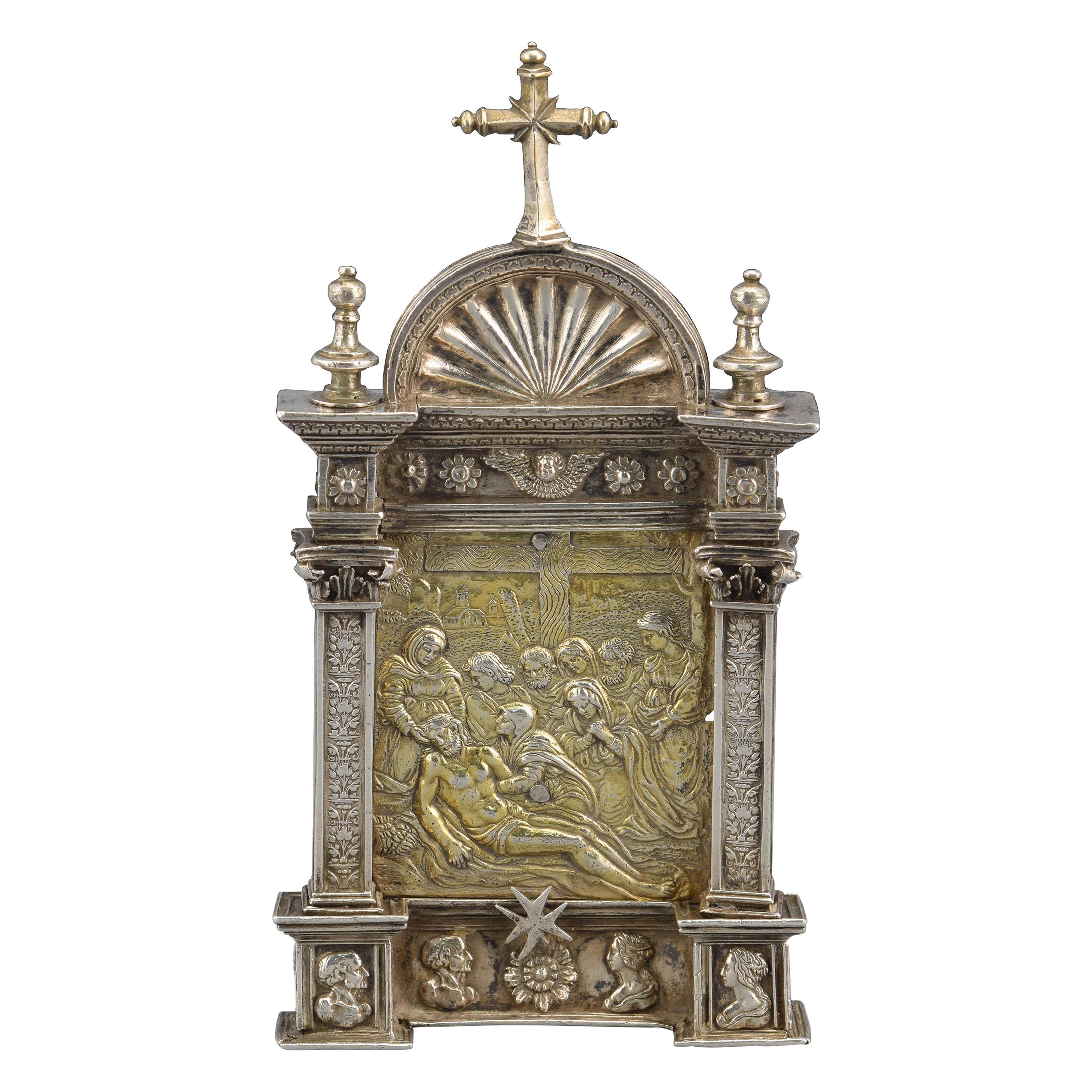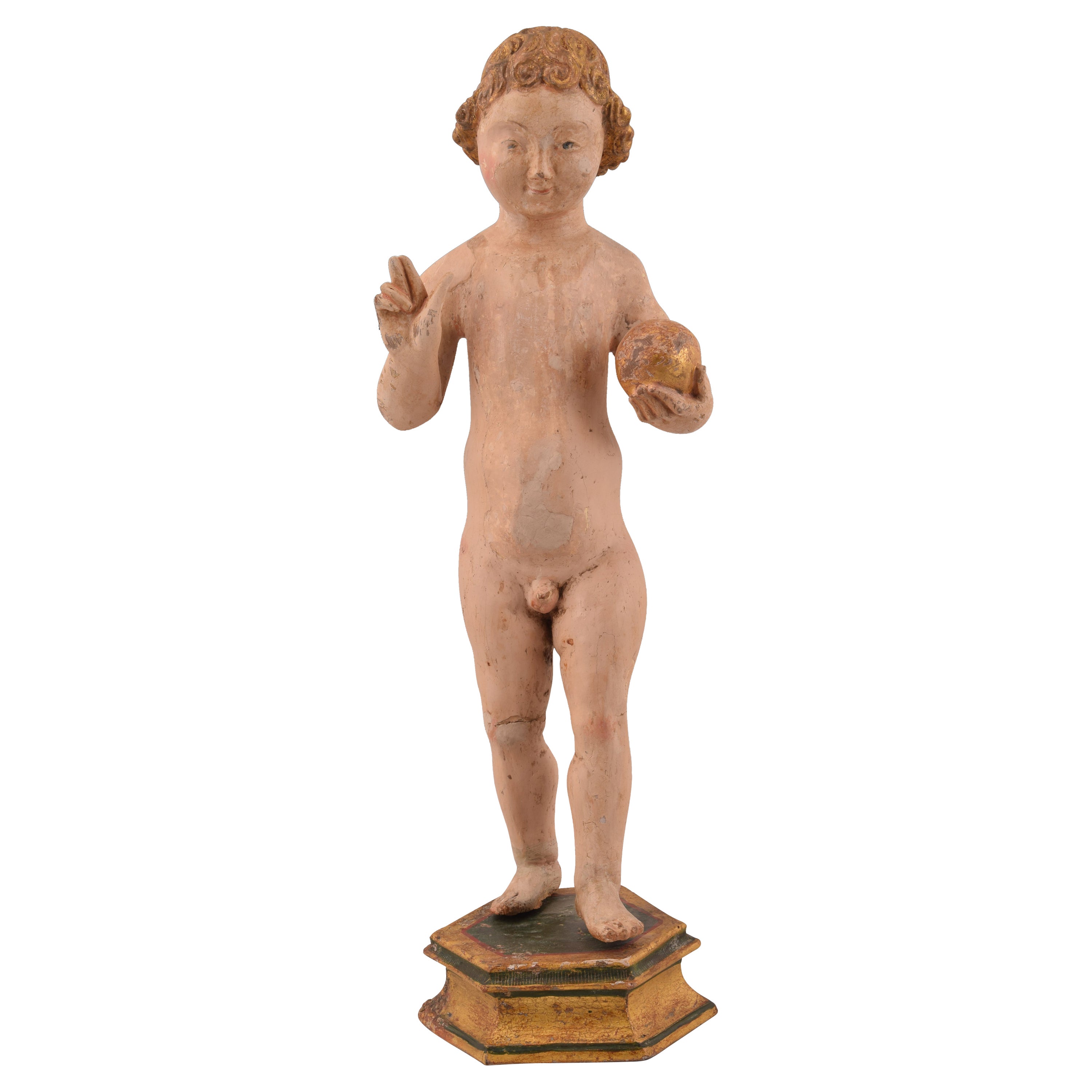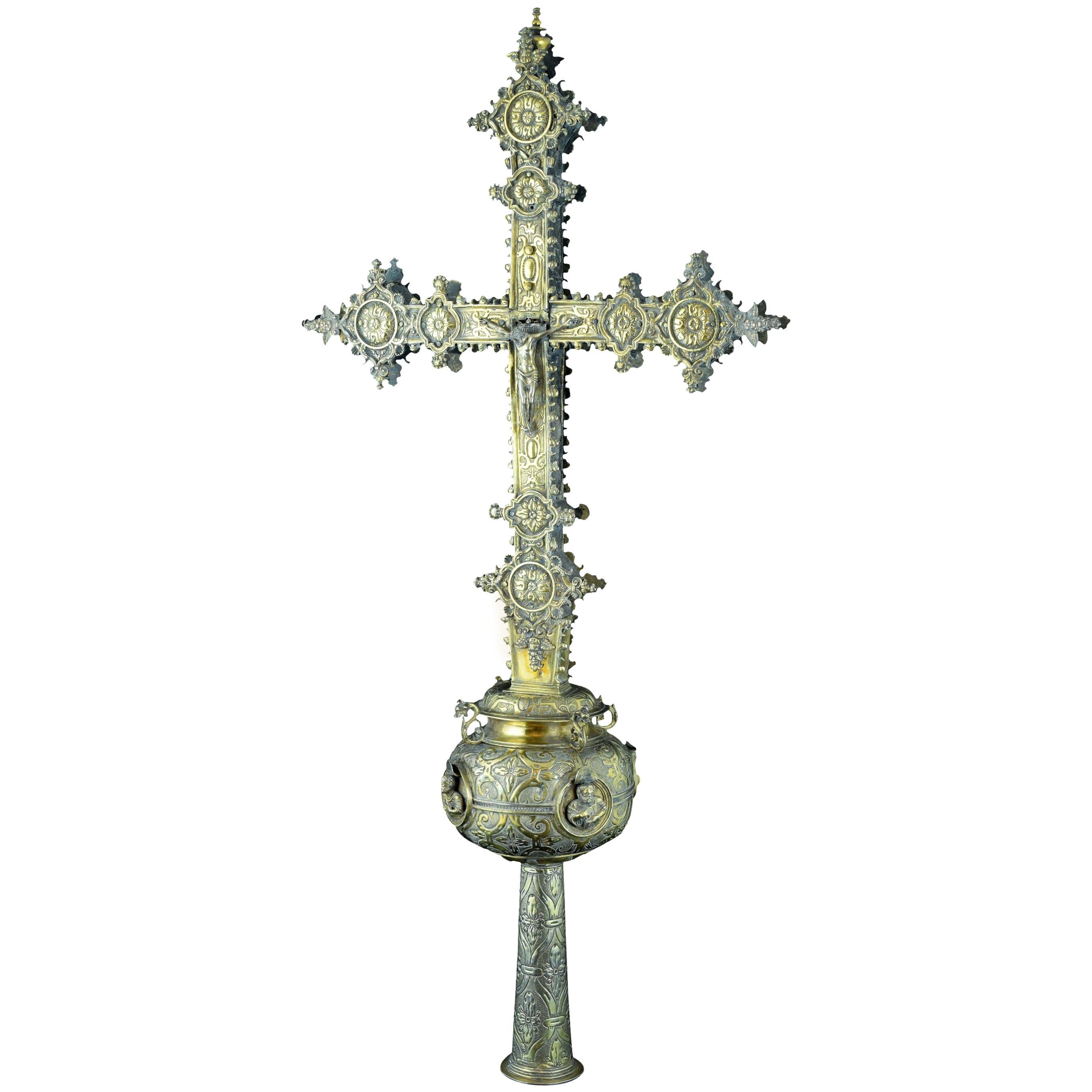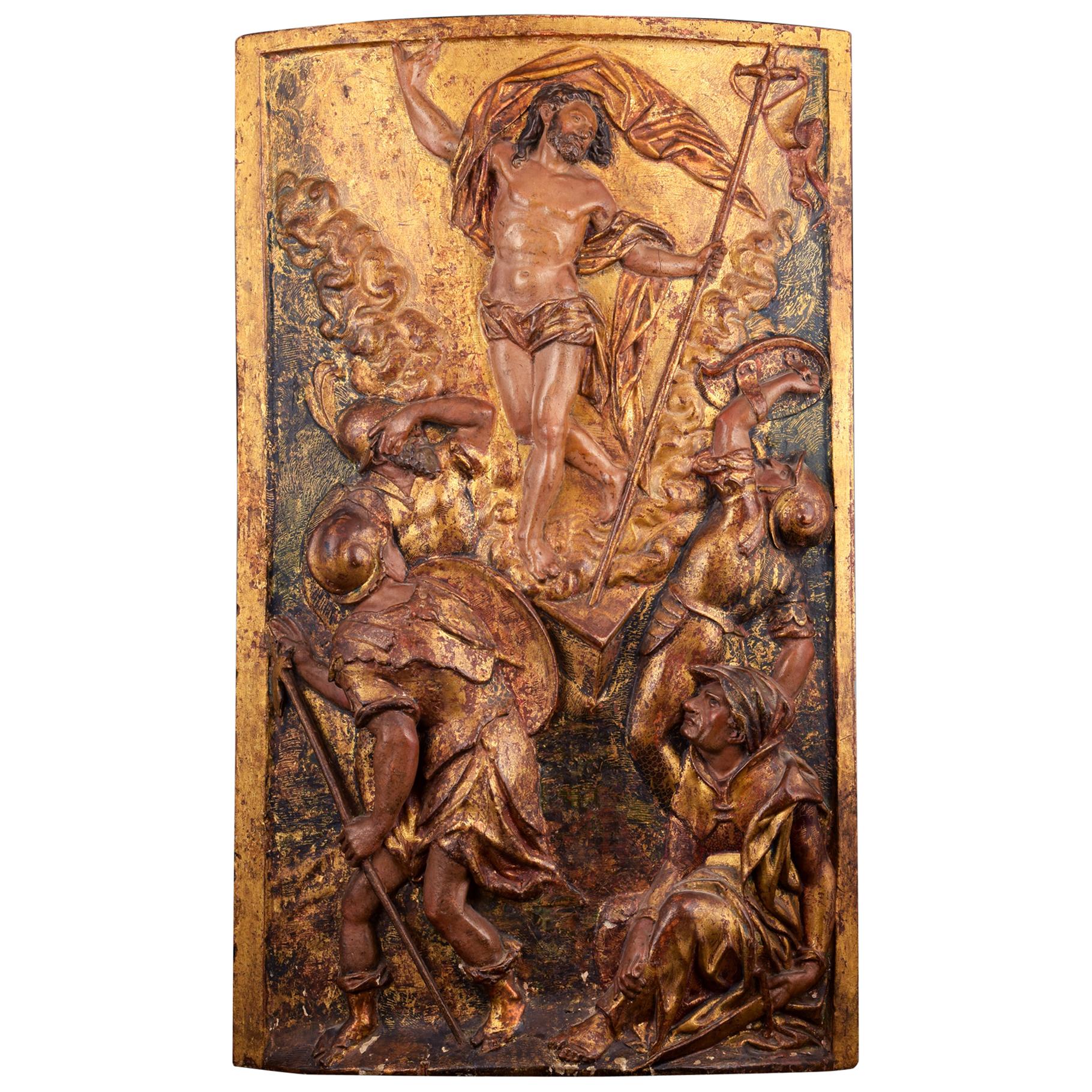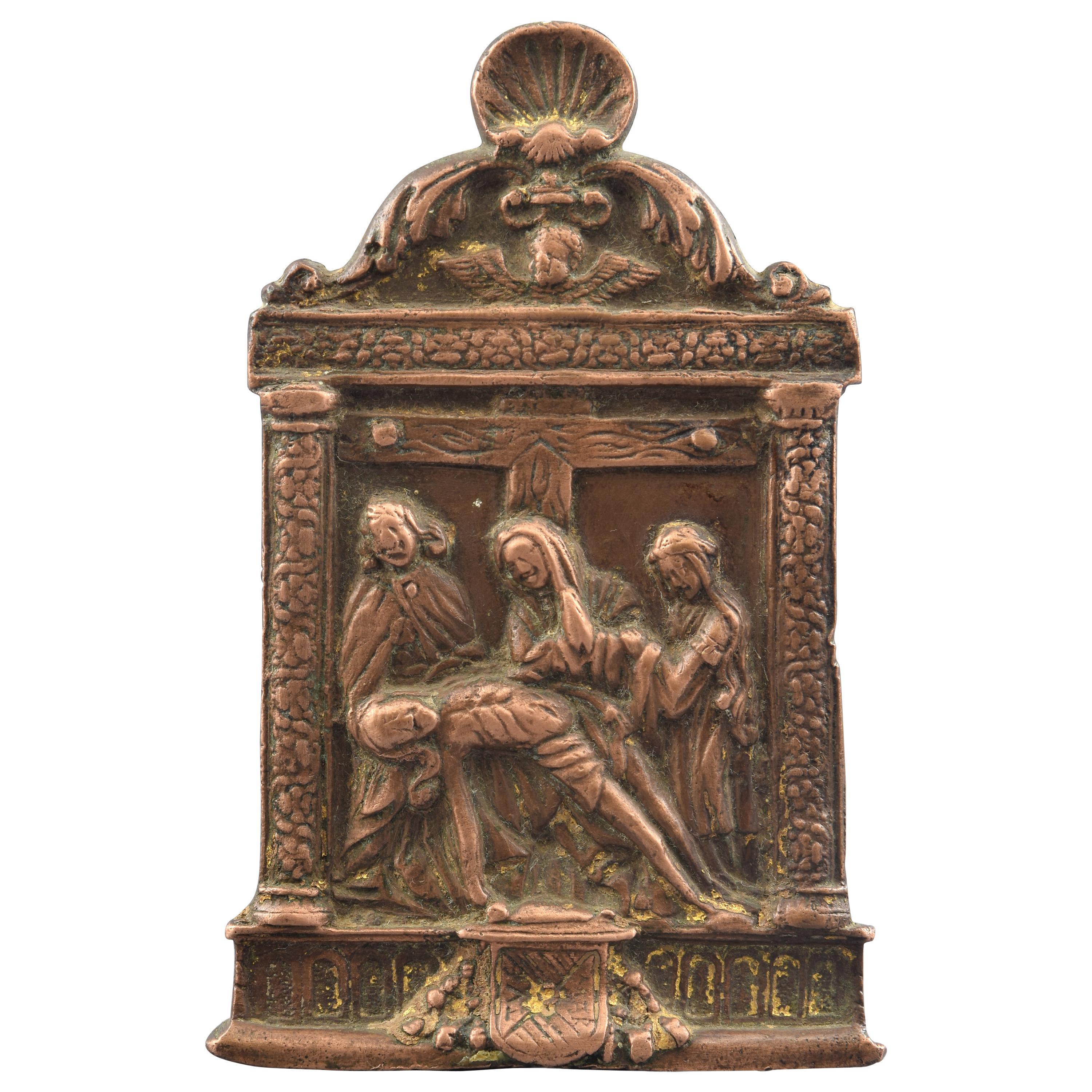Items Similar to Monstrance (temple type). Silver. Spain, 16th century with restorations.
Want more images or videos?
Request additional images or videos from the seller
1 of 21
Monstrance (temple type). Silver. Spain, 16th century with restorations.
About the Item
Portable temple custody. Gilded silver, glass. 16th century, possible restorations.
Custody made of gilded silver (the finish has been lost in some points) composed of a base, an axis or stem and a two-story architectural upper structure with finishing figures. The foot has a flat base on which tubular shapes with discs are placed, followed by a mixtilinear shape with an openwork front with circular details and an upper part with vegetal elements in relief (flowers, scrolls, palms, etc.) and a heraldic shield. The axis or stem begins with an architectural form with flying buttresses and tubular forms with discs (similar to those of the base) and continues with another body of niches with sculptures of saints, which present columns with double-fronted balusters and arches with elements venerated ones topped on the outside by winged angel heads with leaves in their hair; This area ends with an architectural element reminiscent of the lower part. The two-story upper area has a hexagonal base and architectural, figurative and vegetal decorative elements of marked classicist influence along with others of a classic Gothic type, and is topped by a Deesis with a rocky floor (The Virgin and Saint John flanking a Crucified Christ ). Just below the gallery of trefoil arches that finish it below, two garlands of leaves and fruits hang; and two heraldic shields appear engraved. Next, the virile for the Sacred Form is presented, sheltered in a structure with grotesques functioning as columns and angels playing musical instruments. Above this, another structure presents seated children holding the emblems of the Passion and an enclosed space with balustraded balconies with crosses in the center, within which a haloed figure appears blessing and holding an orb topped with a cross (in reality, this figure tops the virile one, but he can be seen through this gap); There are also niches with figures. Between one floor and another, a series of chains appear attached to small poles that ensure that the guard does not open. One of those two engraved heraldic shields already mentioned shows a Tau, also known as the Cross of Santa Tecla or San Antonio, common in Tarragona and in orders such as the Franciscan, for example. The other heraldic shield, which is very similar to the one that appears on the base (here the edge is different, there are more plants...), is presented cut, with a bull or ox passing to the left at the top and three plant stems (perhaps reeds) emerging from the ground (under which there is another line that could allude to a watercourse) in the lower area. The temple monstrances are a relatively frequent typology in the Burgos and Valladolid schools (in fact, it seems to be common in Castilla y León except for some areas such as Palencia), although they appear throughout the Spanish school along with the tower monstrances and the known type. as “of sun”. Compare, for example, with the custody of the Church of Santa Eulalia de Paredes de Nava, or that of the parish of San Pedro de Aibar (dated around 1476-1488, made in Burgos perhaps by Juan de Santa Cruz), that of the parish church of Sasn Juan Bautista in Horta de Sant Joan (Tortosa workshop, 16th century (documentation from around 1520); note the high base, with openwork front with circles), the monstrance of Samaniego (Diocesan Museum of Sacred Art of Euskadi, made by Sancho de Salcedo –doc. Santo Domingo de la Calzada, 1495-1511-), custody of Arisgotas (Parish Museum of Villa de Orgaz, dated before 1547 and made by the Toledo native Francisco Martínez de San Román), etc.
Weight: 3kg. · Size: 21x21x58 cm
International Buyers – Please Note: for those articles that need Export Permits (those older than 100 years), the obtaining of the Permit will be processed without additional expenses (if you choose the seller sends it to you), but the period for the obtention of it may vary from 10 to 35 days.
- Dimensions:Height: 22.84 in (58 cm)Width: 8.27 in (21 cm)Depth: 8.27 in (21 cm)
- Style:Renaissance (In the Style Of)
- Materials and Techniques:
- Place of Origin:
- Period:
- Date of Manufacture:16th century and later
- Condition:Wear consistent with age and use. Minor losses. Minor structural damages. Minor fading. Check pictures and description for details.
- Seller Location:Madrid, ES
- Reference Number:
About the Seller
4.9
Vetted Seller
These experienced sellers undergo a comprehensive evaluation by our team of in-house experts.
Established in 1985
1stDibs seller since 2017
299 sales on 1stDibs
Typical response time: 1 to 2 days
- ShippingRetrieving quote...Ships From: MADRID, Spain
- Return PolicyThis item cannot be returned.
More From This SellerView All
- Silver Pax O Portapaz, Spain, 16th CenturyLocated in Madrid, ESPortapaz. Silver in its color and gilded. Century XVI. Portapaz made of silver that has a handle (decorated with delicate plant motifs similar to those of the pilasters) and a female and a male bust at the bottom, as well as other architectural elements on the back, and, on the front, an architectural composition classicist basement (with busts flanking a flower and a cross), two pilasters (vegetal decoration and capital recalling the composite order) with entablature (flowers flanking an angel's head; moldings), and a semicircular arch finish with elements veined in relief under cross and flanked by two architectural motifs in the upper part. This composition frames and enhances a gilt silver relief where you can see the Lament or Cry over the Body of Christ, with the Virgin holding the head of Jesus, Saint John at her side, the Magdalene and other characters, a cross following the group and a landscape background with houses and plant elements. This architectural structure mentioned is similar to the one present in other 16th century portapaces, such as that of the Magdalena de Dos Hermanas parish (Hernando de Ballesteros el Mozo, around 1575); or that of the Galaroza parish (same author and date); or that of the portapaz of San Miguel de Jerez de los Caballeros (in some details); etc. As for the relief, it is possible to clearly see a strong Italian influence, and the similarity between it and important pieces such as the Portapaz known as “de Cisneros by Juan de Burgos (1493-1497; MuseoCatedralicio de Alcalá de Henares), as well as in paintings and reliefs. Also noteworthy are both the male and female busts in the lower area and the Maltese cross (or Saint John's) that appears in this area. This symbol was used since the 12th century as an insignia by the Knights Hospitallers of the Order of Saint John of Jerusalem, also known as the Order of Malta...Category
Antique 16th Century Spanish Renaissance Religious Items
MaterialsSilver
- Christ Child blessing. Wood. Mechelen, 16th century with restorations.Located in Madrid, ESBaby Jesus on pedestal. Polychrome wood. Mechelen, 16th century, with restorations. Carved and polychrome wooden Child Jesus standing on a pedestal of the same material, standing, a...Category
Antique 16th Century Belgian Renaissance Religious Items
MaterialsOther
- Processional Cross, Silver, Barbastro, Aragón, Spain, 16th CenturyLocated in Madrid, ESWith hallmarks. It is necessary to indicate the survival in this piece of some details from the Spanish Gothic silverware (cresting, which appears around the XV century; the endings ...Category
Antique 16th Century Spanish Renaissance Religious Items
MaterialsSilver
- Wrought Iron Grille, Spain, 16th CenturyLocated in Madrid, ESTypologically, it is a partial architectural grating with an ornamental and defensive purpose at the same time. Likewise, it clearly shows some of the striking decorative and typolog...Category
Antique 16th Century Spanish Renaissance Religious Items
MaterialsWrought Iron
- “Ressurrection”, Polychromed Wood, Spanish School, 16th CenturyLocated in Madrid, ESThe relief was probably a door of the Sagrario. The piece follows a customary decoration in the tabernacles of the Renaissance and the Baroque. Compare, for example, with the sevente...Category
Antique 16th Century Spanish Renaissance Religious Items
MaterialsOther
- Pax or Pax Board, Bronze, Spain, 16th CenturyLocated in Madrid, ESPaper holder bronze, 16th century. Portapaz made of bronze with an "asymmetric" handle on the back, which presents a decoration in light relief framed in an architectural compositio...Category
Antique 16th Century European Renaissance Religious Items
MaterialsBronze
You May Also Like
- Rare 17th Century Silver Reliquary Arm MonstranceLocated in Amsterdam, NLA rare silver reliquary arm with relic bone, with the coat-of-arms of Cosme Roger (1671-1710), bishop of Lombez, France, with original bone relic Poss...Category
Antique Late 17th Century Italian Renaissance Religious Items
MaterialsSterling Silver
- Bronze mortar, Veneto, 16th centuryLocated in Brescia, ITBronze mortar, Veneto, 16th century Lost-wax cast bronze mortar with body outlined by parallel and succeeding frames delineating its circumference. On the two faces, in a central p...Category
Antique 16th Century Italian Renaissance Scientific Instruments
MaterialsBronze
- 16th Century Cast Iron MortarLocated in Brussels, Brussels16th century cast iron mortar with two very beautiful handles Beautiful original object with a great patina and in very good condition.Category
Antique 16th Century French Renaissance Scientific Instruments
MaterialsIron
- 16th century Spanish Bronze Mortar with Letters M on the SidesLocated in Marbella, ES16th century Spanish Bronze Mortar with Letters M on the SidesCategory
Antique 16th Century Spanish Scientific Instruments
MaterialsBronze
- 16th Century Walnut Sculptures from GermanyLocated in Brussels, BrusselsVery elegant sculpture reprenting a Putti (angel) from the German renaissance period -16 century Rare sculpture in walnut of great quality with a very beau...Category
Antique 16th Century German Renaissance Figurative Sculptures
MaterialsWalnut
- Bronze Mortar, Tuscany, Second Half of 16th CenturyLocated in Bruxelles, BEBronze mortar with garlands, flowers and putti - Tuscany , second half of 17th century. Measures: height 10 diameter : 13 cm Artisans and healers used mortars for grinding food...Category
Antique 16th Century Italian Renaissance Scientific Instruments
MaterialsBronze
